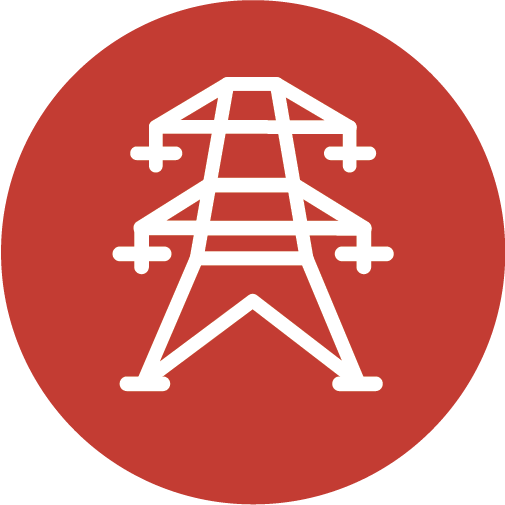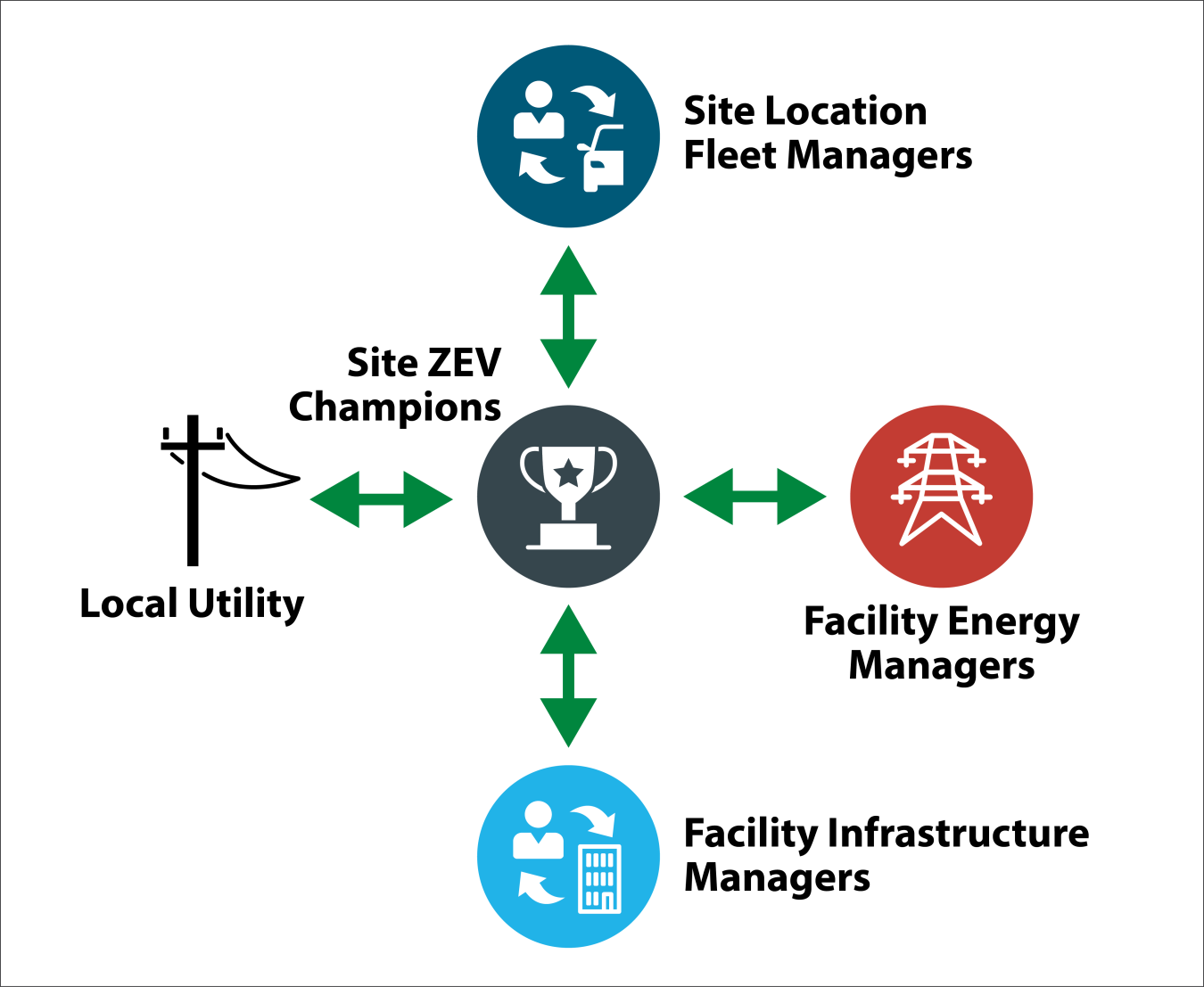Step 8 of the site-level federal fleet electrification process is to engage with key electrification stakeholders at the fleet site.
Navigate the ZEV Ready Process
| Design Phase Steps |
|---|
| 8. Engage with key electrification stakeholders at site |
| 9. Coordinate with local utility service |
| 10. Complete site assessment and design EVSE |
| 11. Identify EVSE at non-agency locations |
| 12. Work with leadership to secure EVSE funding |
Return to the ZEV Ready Center to see all 15 steps.
Primary Audiences
 |
Site ZEV Champions |
 |
Site Location Fleet Managers |
 |
Facility Infrastructure Managers and Utility Staff |
 |
Facility Energy Managers |
Successful electrification requires strong communication and collaboration across many of the fleet location’s key stakeholders. After identifying electrification opportunities at the site location and securing funding commitments, these key fleet electrification stakeholders should develop an EVSE deployment plan and begin the EVSE design process. The site ZEV champion should manage the coordination of local fleet electrification efforts with the site location fleet managers, facility infrastructure manager, facility energy manager, and the local utility service.
Overview: Engage with Key Electrification Stakeholders at Site

One of the key actions to ensure that the design and deployment of charging stations is planned optimally is effective communication and collaboration among the key fleet electrification stakeholders at the fleet site location. The site ZEV champion is responsible for engaging and coordinating with these key fleet electrification stakeholders at the site, including the site fleet manager, facility infrastructure manager, and facility energy manager. Additionally, these stakeholders should engage and coordinate with the local electric utility representative early in the EVSE site design process, as detailed in Step 9: Coordinate with Local Utility Service.
Collaboration with the facility management staff is important as these personnel are typically responsible for both real property and utility management at the location, and may be integral in the siting, procurement, installation, operation, maintenance decisions, and management for the EVSE. Similarly, the facility energy manager can help review and coordinate the impacts of EVSE designs on the overall facility energy plan. DOE recommends developing a charging station deployment team that includes the location’s fleet manager and facility infrastructure manager, as well as utility staff, facility energy managers, and other potential stakeholders.
After identifying the near- and long-term opportunities to acquire ZEVs and deploy EVSE at the fleet location and securing the necessary funds to support the electrification plans, the site ZEV champion and site location fleet managers should construct a team of the key fleet electrification stakeholders at the site to ensure a coordinated approach to ZEV acquisition and EVSE deployment. Once the team is assembled, the site ZEV champion and site location fleet managers should next schedule a kickoff meeting and begin engaging with the identified key fleet electrification stakeholders and agency leadership to discuss site fleet electrification. The key fleet electrification stakeholders should engage with each other throughout the process.
Download the Federal Fleet EVSE Planning Form.
Federal Fleet EVSE Planning Form
All priority stakeholders should complete the Federal Fleet EVSE Planning Form to evaluate planning needs for EVSE at the fleet location. By completing this form, the site location initiates the process to complete an EVSE site assessment and design the EVSE to support ZEV deployment at the facility.
 The Federal Fleet EVSE Planning Form includes a section for contact and location information.
The Federal Fleet EVSE Planning Form includes a section for contact and location information.The team should review the projected acquisition of BEVs and PHEVs at the location by year, using ZPAC tool results if available. This will help inform the number of EVSE that should be deployed at the location to support ZEV acquisitions. The site location should plan for EVSE to be installed before ZEVs arrive if possible, especially to support BEVs. Therefore, it is prudent to install more EVSE than are required in the early years of deployment.
 Fleets can use the data summary from the ZPAC tool to inform step 1 in the Federal Fleet EVSE Planning Form.
Fleets can use the data summary from the ZPAC tool to inform step 1 in the Federal Fleet EVSE Planning Form.The team should complete a listing of the number and location of parking spaces at the fleet location, including (for each parking location) the number of BEVs and PHEVs planned, flexibility in parking locations, existing and unused wall outlets or EVSE, and whether parking is near a wall.
 Fleets can get support from their facility manager or energy manager to complete step 2 in the Federal Fleet EVSE Planning Form.
Fleets can get support from their facility manager or energy manager to complete step 2 in the Federal Fleet EVSE Planning Form.The number of parking spaces informs both the minimum and maximum number of EVSE that may be required at the facility. Section 6.5.7.8 of the U.S. General Services Administration's (GSA's) Public Building Service (PBS) P100 Facilities Standards establishes minimum standards for EVSE chargers for new or significantly modified GSA parking lots. The "quantity and configuration of chargers and ports must be designed to accommodate tenant vehicle usage and locations" as follows:
- Lots with less than 5 federal fleet vehicles must install, at minimum, two charging ports.
- Lots with 5 to 15 federal fleet vehicles must install, at minimum, four charging ports.
- Lots with greater than 15 federal fleet vehicles must install, at minimum, charging ports representing 30 percent of the total planned federal fleet vehicles.
The U.S. Access Board has developed "Design Recommendations for Accessible Electric Vehicle Charging States." When siting EV charging stations, facility managers should review these Design Recommendations, determine their applicability to the project under consideration, and follow their recommendations in order to ensure compliance with the Americans with Disabilities Act (ADA). The Access Board Design Recommendations refer to a forthcoming Rule Making that will further define the implementation of ADA requirements for EVSE.
The team should evaluate the accessibility and availability of electrical service at each parking location, including the proximity to an electrical service panel, spare breaker positions, service panel rating, transformer rating and peak load, and distance from parking spaces to transformer. The team should understand whether any facilities proximal to parking locations are expected to undergo updates or changes to their electrical infrastructure (e.g., installation of additional power capacity to accommodate heat pumps or other building electrification projects). Consolidating electrical service projects will likely help reduce overall EVSE deployment costs.
 Fleets can get support from their facility manager or electrician to complete step 3 in the Federal Fleet EVSE Planning Form.
Fleets can get support from their facility manager or electrician to complete step 3 in the Federal Fleet EVSE Planning Form.The team should document site characteristics, including the facility's ownership, electricity load management system, accessibility by non-fleet vehicles, network and cybersecurity restrictions (GSA is currently navigating the risk management framework for networked EVSE on their blanket purchase agreement), and any permitting requirements.
 The Federal Fleet EVSE Planning Form includes a section for additional information.
The Federal Fleet EVSE Planning Form includes a section for additional information.
Becoming ZEV Ready

As part of the Team Ready component of the ZEV Ready certification, the site ZEV champion is responsible for engaging and collaborating with the key fleet electrification stakeholders at the site, including the site location fleet managers, facility infrastructure managers, and facility energy manager, to ensure a coordinated approach in the design and deployment of charging stations at each fleet location.
| PHASE | ZEV READY | STEP | ACTIONS |
|---|---|---|---|
|
DESIGN |
|
8. Engage with key fleet electrification stakeholders at site location |
✔ The site ZEV champion should engage and coordinate with the key fleet electrification stakeholders at the site, including the site location fleet managers, facility infrastructure managers, and facility energy manager. This includes scheduling a kickoff meeting with the key stakeholders and managing the collaboration as needed in the design and deployment of charging stations. |


